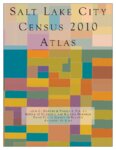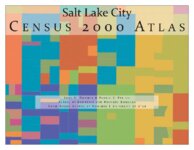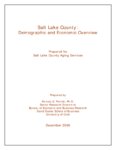TO
Filters: Publication Type: "report" School Or College: "David Eccles School of Business" Collection: "ir_eua"
| Title | Date | Subject | Description | ||
|---|---|---|---|---|---|
| 26 |
 |
Economic, demographic and fiscal impacts of closing Hill Air Force Base: a statewide and regional analysis | 2004-04 | The upcoming round of Defense Base Closure and Realignment (BRAC) is threatening the existence of Hill Air Force Base (Hill AFB). The Department of Defense is aggressively approaching this round of BRAC in its attempt to eliminate 20% to 25% of current capacity. The purpose of this study is to asses... | |
| 27 |
 |
Salt Lake County's distinctive demographics: implications for the aging population | 2006-12 | Salt Lake County; Projections; Estimates; Aging population; Baby boom; Utah; Salt Lake Aging Services; Kennecott Land | Salt Lake County is the economic, political, and cultural center of Utah. The county is currently home to nearly 40 percent of Utah residents and generates about half of all jobs in the state. It remains the most populous county, with a million of the state's 2.6 million residents,1 and its daytime ... |
| 28 |
 |
Salt Lake City census 2010 atlas | 2013-02 | Demographics; Salt Lake City; Utah; Census | This volume presents and analyzes results from the 2010 Census of Population and Housing. This mandatory enumeration is conducted by the federal government and is used to determine reapportionment and redistricting. This is the most complete record of population, households, and housing units that i... |
| 29 |
 |
Salt Lake City census 2000 atlas | 2011-03 | Demographics; Salt Lake City; Utah; Census | This volume presents the basic demographic characteristics of residents of Salt Lake City as recorded in the 2000 Census of Population and Housing. Every ten years these federal governm ent counts of people are the basis of congressional apportionment and political redistricting. Data in this volume... |
| 30 |
 |
Salt Lake County: demographic and economic overview | 2006-12 | Salt Lake County; Utah; Demographics; Aging; Dependency ratio; Foreign born; Immigrants; Age structure; Age waves; Occupation; Labor force participation; Sex ratio; Educational attainment; commuting | Salt Lake County is the economic, political, and cultural center of Utah. The county is currently home to nearly 40 percent of Utah residents and generates about half of all jobs in the state. It remains the most populous county, with a million of the state's 2.6 million residents,1 and its daytime ... |
| 31 |
 |
The structure and economic impact of Utah's coal industry | 2010-05 | Coal; Utah; Economic impact; Carbon County; Emery County; Sevier County; Employment; Earnings; Construction; Retail sales; Carbon sequestration; Carbon capture | Utah's coal industry has played a significant role in the economic development of the state for well over a century. The future of the industry is dependent upon a constellation of economic, technical, and policy developments. This study of Utah's coal industry is composed of the following sections:... |
| 32 |
 |
A projections model for small area economies | 1966-06 | ||
| 33 |
 |
Estimates and projections of low income population in Utah 1970-1985 | 1977 | This i s one in a series of projections and estimates of "target populations" defined by the Utah Department of Social Services for planning, management, and budgeting purposes. The fourteen target populations are: | |
| 34 |
 |
Procedure for using the matrix inversion routine | the spint modity programs allow the used to modity a spint matrix. It also, copies information at the beginning and end of a life which allows it to process impact files, etc. | ||
| 35 |
 |
UPED79 Report on revisions of the Utah process economic and demographic impact model (UPED) | 1980-01 | This report describes the Utah Process Economic and Demographic Impact Simulation Model (UPED) and the computer soft ware that implements it as they have been developed and refined as of February, 1980. The acronym UPED79 refers explicitly to the refinements to the model and its software which were ... | |
| 36 |
 |
1984 baseline projections executive summary | 1984-09 | ||
| 37 |
 |
Critical issues in Utah's future: volume II | 1977-02 | ||
| 38 |
 |
Uped model revision report on completion of work item I contract for services | 1978-10-05 | This report is submitted in completion of Work Item I of the referenced contract between the State Planning Coordinator's Office (SPCO) and the Bureau of Economic and Business Research, University of Utah (BEBR). The report is in two sections: The first section presents the narrative discussion of t... | |
| 39 |
 |
Methodology for forecasting and allocating population, employment and land use along the Wasatch Front | 1970-09 | The report which follows presents a methodology for forecasting population, employment and land use patterns along the Wasatch Front. The methodology combines and mathematical model with a mapping analysis. Both are flexible and can be applied to transportation areas, counties, census tracts and tra... | |
| 40 |
 |
Barriers to industrial development in Utah's portion of the four corners region | 1970-06-01 | Utah's portion of the Four Corners area is composed of the 21 counties which are south and/or east of Salt Lake County. The Utah Four Corners area covers 65,000 square miles which is approximately 80 percent of the state. The are a has a population of 274,500 dispersed throughout the region in a ver... | |
| 41 |
 |
The changing composition of the State budget | 1976-04 | An issue of vital concern to all taxpayers and administrators of government is the distribution of state revenues from the various accounts to the departments of state government. A detailed account of the growth and changing patterns of state expenditures from 1969 to 1975 is presented in this issu... | |
| 42 |
 |
A spatial allocation model for regional impact projections | |||
| 43 |
 |
State of Utah economic and demographic projections: 2000-2030, 2000 baseline highlights | 2001-01 | ||
| 44 |
 |
Employment and population analysis and projections Salt Lake Metropolitan Area, Utah and the United States | 1962-09 | Thomas A. McLean and Mrs. Connie P. Faulkner, graduate students in the Department of Economics, rendered very valuable assistance in the preparation of this report. The Utah Department of Employment Security was most cooperative and helpful in making available the necessary basic data for this stud... |
